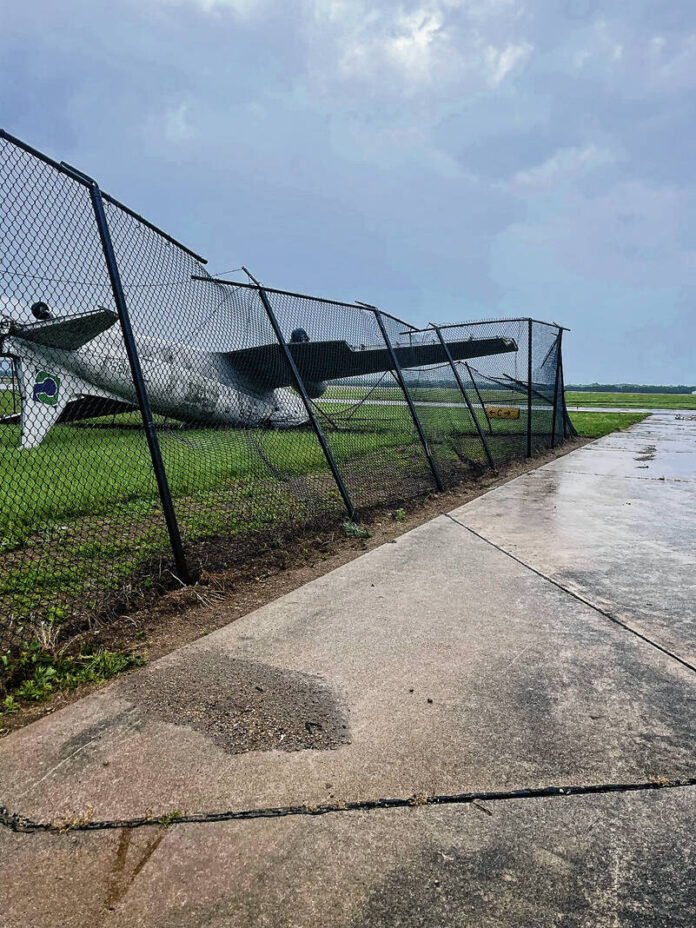
Photo provided An old C-47 rests upside-down on a fence at Columbus Municipal Airport in Columbus, Ind., Tuesday, June 7, 2022. The aircraft was blown over by strong winds during the severe thunderstorms that hit Columbus in May. Firefighters used the plane to train in aircraft rescue.
Columbus Municipal Airport plans to auction off a piece of inoperable aircraft — possibly for use in restoration projects — following its recent spin in a thunderstorm.
A DC-3C used by the airport for Aircraft Rescue and Firefighting training was damaged during an afternoon storm on May 21, said Airport Director Brian Payne. The control tower notified airport officials that the aircraft had flipped over. Following the storm, they examined the damage and made sure the plane wasn’t on any active runways. After that, there wasn’t much that could be done right away.
“It appears that the very first gust of wind — the very significantly strong gust of wind — broke all of the strapping that we had and popped all the chocks and such that was around the wheels and holding the aircraft to the ground,” Payne said. “It appears to have started rolling and rolled back into the fence. … And the sustained wind just lifted the aircraft up and flipped it over.”
He said this was likely due to how light the aircraft is. In its current state, it has no engines or fuel to weigh it down.
“All of that was stripped out of the aircraft already,” he said. “Even all of the control surfaces, so the ailerons and flaps and elevator and rudder — all of those pieces had been removed from the aircraft before. The interior of the aircraft was completely hollow. So the aircraft was very light … and clearly, with the size of wing it was, had a lot of lift component to it.”
Payne estimated that the DC-3C had not flown in more than 20 years, and the airport had owned it for about eight years. It was previously owned by Rhoades Aviation and used for cargo flights. The business then sold it to a company out of state. However, the company never came to pick up their purchase, and the plane sat idly on the west ramp for several years.
“At some point we called it a derelict aircraft because the company wouldn’t come to get it,” said Payne. “The company essentially just said, ‘You can just take the airplane. We don’t want it.’”
The plane was already stripped bare when it entered the airport’s possession, and aviation officials took it “as is.” Payne said he suspects various interior pieces had been sold off.
About eight years ago, Payne and Columbus Fire Department Chief Andy Lay — who was a firefighter and heard of the airport’s Aircraft Rescue and Firefighting (ARFF) division at the time— visited Indianapolis’ airport and took a tour of their ARFF division, which had a full-sized aircraft to help with training.
On the way back from their trip, Payne suggested that they use the DC-3C which had recently come into the airport’s possession, to do something similar. He and Lay then developed ARFF modules and ways to incorporate the plane in training.
For instance, the plane was used to help firefighters simulate approaching an aircraft and spraying it down while still inside a firetruck. Firefighters were also able to practice entering the aircraft in smoky conditions to simulate rescues.
“We tried really hard not to do any damage to the aircraft … as far as any more damage than was already done, because it was not in great shape anyway,” said Payne. “But we made sure not to really punch any holes or cut doors open or anything. So the firefighters did a nice job respecting the aircraft as they were training.”
He said it’s unfortunate that the plane was damaged by the storm.
“I don’t know what more we could have done, but we certainly hate to see it go like it did,” he said.
The morning after the storm, the airport shared the news on social media. Payne said he initially posted about it because people had been talking about a plane flipping, and he wanted to make it clear that it was just used for firefighter training.
“That’s the reason why I put it out there,” he said. “But then, once we did, we talked about how do we kind of give back? Just as our museum has been able to secure pieces from across the United States for the C-119, hopefully there were other museums who were restoring an aircraft similar to this that would be able to use at least some parts or pieces of it.”
As of June 1, four interested parties — including museums and restorers — had reached out to the airport to express their interest in the plane, which comes from an interesting background.
The Federal Aviation Administration’s records state that the plane is Douglas DC-3C, manufactured in 1943. Per the Aviation Safety Network, DC-3C is the designation for ex-military C-47, C-53 and R4D aircraft rebuilt by Douglas Aircraft. All three are members of the DC-3/C-47 family of aircraft.
According to the Smithsonian Air and Space Museum, the C-47 was created as a militarized version of the DC-3 airliner. C-47 aircraft — also known as “the Gooney Bird” — were the Allies’ primary military transport during World War II and carried paratroopers in a number of operations, including D-Day. General Dwight D. Eisenhower called it one of the Allies’ greatest assets in their victory over the Axis powers.
Payne said that the airport’s next step will likely be to designate its DC-3C as a surplus piece of equipment at the Board of Aviation Commissioners’ next meeting, which is set for June 14. They would then sell it off on the same auction site they use to dispose of other surplus items.
For now, the aircraft will remain in the same upside-down position it was after the storm. Payne said that some of the interested museums requested that the airport not move or flip the plane, as doing so could damage the landing gear (which currently faces upward due to the flip). Whoever purchases the plane would likely come to the airport in person to disassemble the plane in its current position, rather than try to move the whole thing.
One of the interested parties only wants a couple of hinges and small door on the nose. He compared their project to that of the local C-119, with organizers wanting to restore their aircraft in a way that’s as close to the original as possible.
“We have had some that reached out for very specific items like that,” he said. “… And then a couple of them just wanted the entire aircraft to restore an aircraft that they’re working on, so utilizing pieces and parts from that aircraft. So we’ll see. Whichever entity ends up winning the bid on the auction will obviously be the prime. And then we’ll see if we can’t work together with all of the other entities to make sure that everybody hopefully gets the pieces and parts that they need.”
When asked if the airport will seek a replacement for the plane during ARFF training, Payne said this is their goal. He added that the airport has an old helicopter that can be used for some of the same exercises, but they will likely look into replacing the DC-3C to make sure firefighters are well trained.
“We’ll just kind of keep our eye out, what we can salvage from someone else down the road,” he said.




